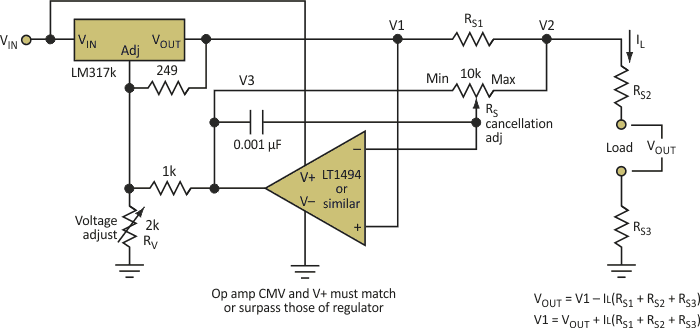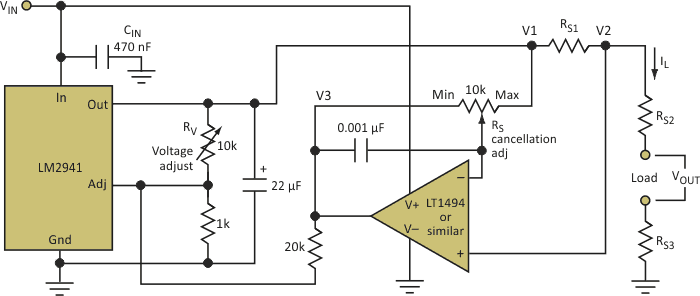Linear regulator ICs offer simple, efficient, and effective solutions in a multitude of low- to moderate-power voltage regulation applications. They also provide opportunities for many simple application tricks that stretch their performance and push their suitability into tasks that need a bit more capability and versatility than the ICs can manage on their own. One example is supplying power to a load that’s separated from the regulator by interconnecting wiring with substantial resistance – for example, when the regulator is located some distance from the load.
The classic solution to poor load regulation due to interconnection resistance is, of course, the four-wire Kelvin connection, in which the regulator sense connections are run separately from the load current conductors. Clever off-chip circuits have long been available to implement Kelvin connections for IC regulators [1]. But sometimes the added connections and wiring of the Kelvin topology is not convenient or cost effective. This idea describes an alternative that doesn’t use them.
 |
|
| Figure 1. | By developing a correction voltage using a separate current-sampling resistance, designers can eliminate the added circuitry of the four-wire Kelvin connection. |
The extra sense wires can be eliminated if the necessary VOUT correction voltage is developed from a separate current-sampling resistance: RS1 (Fig. 1). RS1 should have roughly the same resistance as the interconnection (wiring) resistances RS2 and RS3 (generally a few tens to hundreds of milliohms). In fact, it can be as simple as a meandering printed-circuit board trace. The op amp then sums a scaled version of the RS1 sampled voltage with the regulator output V1 to produce corrected feedback and net load power VOUT that is constant and independent of load current.
 |
|
| Figure 2. | This variation of the circuit provides negative feedback for regulators that use a ground-referred reference voltage, like the LM2941. |
The necessary polarity of the compensatory feedback depends on the style of regulator being used. Regulators that maintain a constant voltage differential between output and adjust pins (for example, the LM317) require positive feedback. Regulators that use a ground-referred reference voltage (for example, the LM2941) need negative feedback (Fig. 2). But in both cases, the feedback scale factor is adjusted using the same two-step procedure:
- With no load applied (IL = 0), adjust RV for the desired VOUT.
- Apply full load (IL = max) and adjust RS to restore the target VOUT.